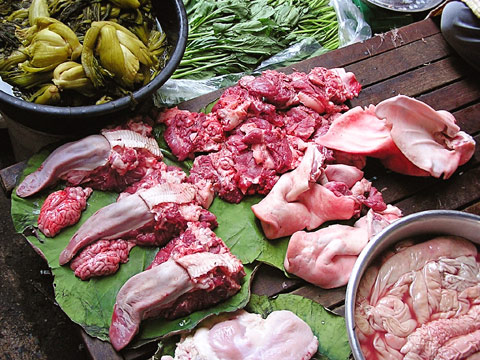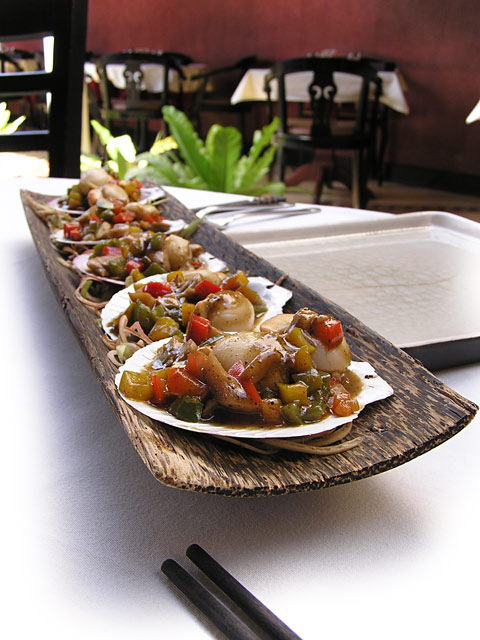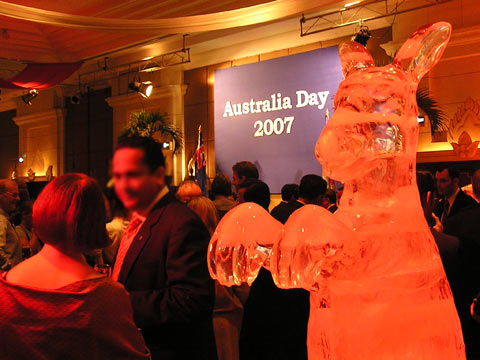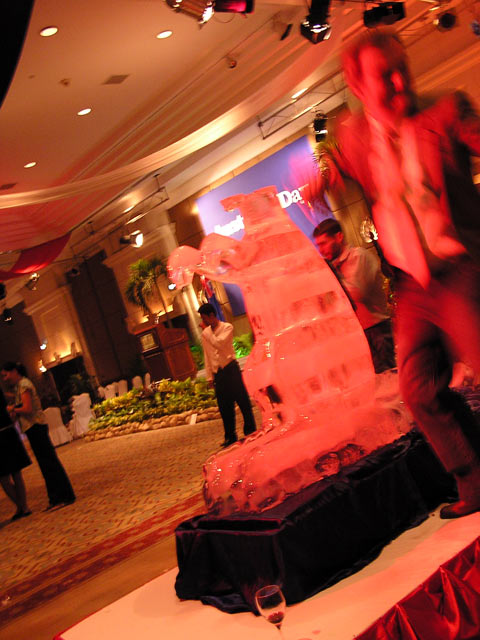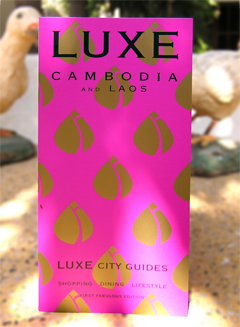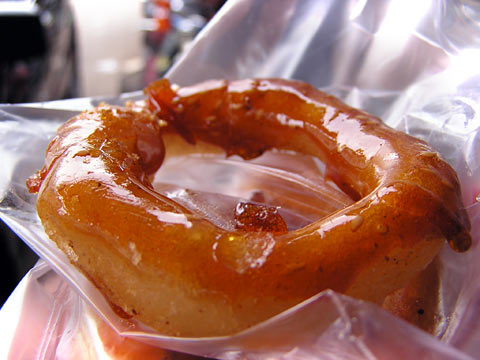Continuing with the Phnomenon/RealThai love-in, Austin over at RealThai reviews one of my favourite Khmer restaurants in Phnom Penh: Sweet Café on St.294. For potential stalkers, it opens with a photo of me looking mighty pleased at my bowl of samlor machou yuon and follows with some beautifully shot images of amok trei (fish amok), porng tea trei prama (semi-dried fish omelette, with a hearty dose of fatty pork and a much less hearty dose of trei prama), bok svay (pounded green mango salad with deep-fried dried fish) and the aforementioned sour “Vietnamese” soup. Also featured is a photo essay on various food vendors around Phnom Penh.
Real Khmer? Cambodian fine dining in Phnom Penh
“I hope I’m not going to wake up to that tomorrow morning”, Austin mentioned as I took the above photo.
Good morning, Austin.
I spent last weekend with Austin from RealThai while he crafts a piece for a Thai newspaper about Phnom Penh as a weekend destination, and takes photos in a manner much more professional than mine. He was keen on me showing him some of the less fluffy edges of Cambodian food (see pig parts, above, from Psar Orussei) that we could use for our own purposes. It is always a pleasure to travel about Phnom Penh with a fresh set of eyes and compare notes on respective adopted nations’ cuisines. Austin has an encyclopedic knowledge of Thai food, whereas my knowledge of Khmer cuisine is much more like an 1880’s Children’s Primer: One part shipping tables; one part unverifiable observation; three parts Tales of Interest in Foreign Lands. When Austin invited me along to provide local insights into Phnom Penh’s top end at the restaurants’ expense, how could I refuse? I consulted my shipping tables to check my availability with the tides.
Chef Luu Meng from Malis was a genuine surprise. Since I had last eaten at Malis about six months ago, Luu Meng had tweaked the menu to add some homier Khmer food (a few basic, herb-rich soups) and altered the street-level layout to look a little classier with a paintjob, fewer tables and some deep couches.
Meng spoke at length on the primacy of freshness, the importance of the Mekong’s rise and fall to affect the seasonal growth of local herbs and the migration of Cambodian freshwater fish. He devoted twenty minutes to speaking on the flavour profile of th’noeng leaf which he describes broadly as somewhere between “green mango and tamarind”, and the huge difference between maom leaf (“Vietnamese!”) and ma-aum leaf (basil’s lovechild with spearmint). He spoke about being excited about Indian food and about weaning his staff from their previous MSG habits (none is used in his kitchen).
In between chatting we ate a handful of journo-friendly plates : fish amok, kroueng-coated chicken wings, local scallops with pepper (pictured above), and beef in bamboo. Most hit the more Chinese end of Khmer cuisine – Luu Meng is a man who wholeheartedly embraces the capsicum.
Night was reserved for the Khmer degustation menu at Raffles Hotel Le Royal’s fine dining effort, Restaurant Le Royal. After chatting with Luu Meng, I was openly optimistic about the direction that this New Khmer Cuisine was taking in Phnom Penh. I had also previously eaten a seriously good bowl of pho at a conference buffet at Le Royal but never set foot in their fine dining area.
Jan, our maître d’hotel/sommelier, described the menu, suggested wines, and was an altogether ideal host. European wines are not my strong point: I’ve got a decent grip on varietals but come from a background of drinking too many tannin-heavy Aussie reds, some of which from a box rather than a bottle. He made one of the best wine/food pairings that I’ve had in Cambodia. After describing Southern German terroir with glee, he picked a 2005 Wittmann Estate Riesling which was acidic but with sweetness on the back palate that fits perfectly with both the richer and subtly spicy elements of Khmer food. The nose of peaches was clear enough to bring back my grim memories of working in a central Victorian orchard, memories that in hindsight I should have appreciated as a small omen.
The trio of starters was locally inspired, only in the loosest sense. The pared-down mango salad contained chopped capsicum instead of chilli, dried shrimps mashed to a fine paste rather than whole with no real seafood punch. This was accompanied by two slices of West Coast scallops on triangle of banana leaf and a pair of wonton parcels with hoi sin sauce. I’m a fan of when chef’s pay attention to texture, which was evident, but the salad was pared back to being barely recognizable as Khmer, and the other two components could have come from literally anywhere.
I questioned our waiter in Khmer as to whether the forthcoming Pumpkin Soup was Samlor Karko, a Hindu-influenced Khmer soup which amongst other ingredients, contains pumpkin.
“No”, he answered, “It’s samlor lapov” : quite literally “Soup Pumpkin” followed by a grin.
There is a grin of nervousness in Cambodia. Ask a local about the current regime, the Khmer Rouge, or their dead parents and you’ll get the same grin. For a Westerner, there is nothing more unnerving than having a local describe their tales of torture and terror under the Khmer Rouge whilst they give you an unflinching and toothy smile. I hoped that the nervousness was more about the service staff suddenly realising that I could understand them a little when they were musing in Khmer about the sexuality of two young white men eating together by candlelight, rather than about the soup. I was tempted to confirm with them that Austin actually was my alluring Thai songsaa*.
The pureed pumpkin soup arrived topped with a square of gold leaf. It bore no resemblance to Khmer food, just as my bleak peach harvest memories bore no relationship to my continued enjoyment of the riesling. As a curious coincidence, I’d left my inamorata (who now wishes to be referred to as such in print and in person) at home defrosting herself a bowl of pumpkin soup from the freezer which she’d previously packed full of fresh Khmer ginger, lemongrass and coconut. It was the last aroma that I could smell when I left my house and now I longed for that soup rather than the one in front of me.
Between soup and mains, the Rosicrucian-ly named Executive Chef Christian Rose devoted us a half hour of his time. He spoke guardedly about Khmer food choices and regarded us with slight suspicion when we asked about sourcing local ingredients, about local Cambodian restaurants (his recommendations: Khmer Surin, Malis, beachside seafood in Sihanoukville), and about the interest of his guests in Khmer cuisine. There appeared to be very little interest despite his assurances to the contrary.
Scattered amongst the conversation, he name-dropped his upmarket ingredients and recipes: West Coast scallops; beluga caviar; Wagyu beef (“Grade 9, not Japanese but with excellent marbling”); a multiple course duck degustation; an entire constellation of foods alien to the Cambodian culinary cosmos. This was the food of international excess, high diplomacy and hardcore local corruption. Does serving this food in a starving nation make you complicit? Does eating it? The mains arrived to break our conversation before I got the chance to head it in a lachrymose direction.
The following beef loc lac hit the right note: beef (not a cut of Wagyu, which would be a foolish excess), fresh pepper from Kurata Pepper, stock reduction – completely unlike your regular loc lac which is generally made with bottled soy and tomato sauce : and so a positive top-end innovation. This was paired with a miscellaneous coconut curry with a hearty chunk of fresh bawngkang (river lobster) tail meat, a few batons of vegetable matter and a minute mound of rice. Desserts were a wide selection of Khmer sweets and I caused a small commotion when I asked the waiter to name a more obscure one (I thought num lhong, but it was revealed to be the similarly shaped num bhor por).
We rolled out of Le Royal after four hours of well-paced food conversation, great wine and barely Cambodian food.
Meals and wine at Restaurant Le Royal and Malis were provided free of charge. Malis is located on Norodom Blvd, just south of the Independence Monument. Restaurant Le Royal is located in Raffles Hotel Le Royal on the corner of St.92 and Monivong Blvd. Enter via the main foyer and turn left.
See Also: Seeing how the other half lives – Malis and Pacharan, Austin’s RealThai
Continue reading Real Khmer? Cambodian fine dining in Phnom Penh
Your taxpayer dollars buy me a frozen kangaroo.
Happy Australia Day 2007.
Australian expats in Cambodia celebrated in the traditional manner by getting their booze on at the complete expense of the Australian Embassy. I had originally planned a detailed review of the food on offer (lamingtons, Australian rib eye beef, sausage rolls, pho) but was too bewildered by the carved ice monsters and 5 metre long Harbour Bridge to concentrate or take detailed notes.
Sadly the above iced marsupial could not withstand the onslaught from a disgruntled expatriate, and was swiftly beheaded in a single drunken blow.
Angkor: Built with the blood of slaves for your tourism pleasure
I was teaching classes at a local research institution. I arrogantly would always trot out the notion of the Angkor Empire in my examples. Angkor was, in my opinion then as now, a horrendous deformation of humanity, where slave labor and mass dehumanization resulted in the piling of rocks into beautiful monuments. The vast majority of modern Cambodians, however, for a host of reasons which are increasingly well understood(2) think of the Angkorean regime as the golden age of Cambodia. Historically, this cannot have been true, at least not for the masses of people who lived under Angkor’s rule. Instead, modern Cambodians appeal to Angkor primarily as an offense against the constriction of the Cambodian nation (in terms of territory, glory, and regional power), a notion explored very well by Thongchai Winichakul for Thailand.(3) In my classes, I would ask people if they would want to have lived during the Angkor era. All my students smiled beatifically and replied that yes, they would.
I then asked them if they were under the impression that they would have been kings, queens, or if they would have been the slaves who built the palaces. Their smiles dropped, and their responses were a combination of shame and sullen silence. I was frustrated too. I supposed I had expected some sort of ‘a-ha’ moment where their eyes would suddenly open onto a vista of oppression and slavery of which they were unaware. This is what I mean by referring to my previous arrogance.
It is an extreme rarity to read nuanced and academic accounts of Cambodia as they happen, which is what makes Deathpower in Cambodia a great read. Probably less of a great read for anybody who yells “wanker” whenever I mention an obscure theorist or add footnotes (Erik listed Deleuze and Guattari’s Anti-Oedipus amongst his heavy holiday reading).
Oddly enough, as an outsider I tend to display the same arrogance about Cambodian food. Not many Cambodians enjoy discussing that banh xeo, loc lac and samlor machou yuon in all likelihood had Vietnamese (or even Khmer Krom) origins nor do they find it as interesting to discuss how these dishes became so intimately entwined in a monolithic idea of Cambodian cuisine and modern-day Cambodian nationalism. They’re all Cambodian foods now because Cambodians have so thoroughly claimed ownership over them and modified them to their own tastes, but it’s rare to find a local who does not believe that Khmer culture (and as an extension, food) magically appeared sui generis in the hazy Angkorean past.
Third World de Luxe: Luxe City Guides Cambodia and Laos
Since imperial powers began extending their sovereignty abroad, Third World nations have been ripe for the picking as luxury travel destinations. What the colonial era lacked in wifi facilities and post-Orientalist irony, it made up for with linen suits and mahouts. Any colonising nation with the nous to build a hill station knew that luxury travellers would soon follow, even if those travellers were the bored ruling elite and the tuberculosis-ridden. Late last year, bespoke guide-crafters Luxe City Guides caught onto this hundreds year old trend and released its first truly Third World guide concatenating Laos and Cambodia. What it lacks in directions for Indochina’s best Directly Observed Therapy destinations for TB sufferers, it makes up for in postcolonial drollness for the jaded colonisers.
Luxe is an excellent concept notwithstanding their occasional pretentious wankery. The Luxe model is where travel guides of the future are headed: know your market niche incredibly well and then recommend where to go, as opposed to the Lonely Planet model of encyclopaedic listing and loose attempts at objectivity. People like choice but not too much choice.
The other real beauty of the Luxe City Guides is that somebody who lives in the same city as the guide usually writes them. This one is not, by virtue of covering four urban centres (Phnom Penh, Siem Reap, Vientiane, Luang Prabang). Author Jo Craig’s home province of Siem Reap receives better coverage than Phnom Penh but I wonder if this is mostly because there is so little choice of anywhere decent to eat, drink or shop in Siem Reap (if you want to avoid the “people who carry their own luggage”, in Luxe’s parlance). The tips for visiting the Angkor complex are so well known that both the free Canby Guides and the Lonely Planet mention all of them, which is not any great surprise given that tourists/invaders have been holidaying/pillaging at Angkor for a few hundred years. Angkor Wat still holds some secrets but the only way that you will find them is with a skilled excavation team.
For Phnom Penh, the recommendations are mostly a taste of the obvious. Shopping in Phnom Penh? Walk along St. 240 and St.178; shop wherever looks like a Western store. I was hoping for a few of the truly excellent local shopping secrets, like the 50s antique warehouses in Stung Meanchey or the best place to commission yourself a hand-painted Khmer road sign before the artists who make them die out. These will stay local shops for local people. The much more obvious omission is Cambodia’s markets. There’s a passing reference to Psar Thmei (Central Market) and the Sorya Mall, but that is all. Every expat in town has a Luxe-ish market secret but they’re obviously being held tightly to their chests.
The other false assumption that I have made is that when people visit Cambodia that they are keen to eat some Cambodian food (Disclosure: I write popular Phnom Penh-based Cambodian food site, Phnomenon). In Phnom Penh, three Khmer restaurants get a mention, preceded with the warning that “you’re unlikely to be swooning over Khmer cuisine”. Swooning guardedly about Cambodian food is my stock in trade but it is difficult for me to take too much umbrage when the top-end of Khmer cuisine in Phnom Penh is still under development.
The winners:
Maxine’s (Snowy’s) : Laudable bar owner Snowy pulls off a Fiji-sized coup by suddenly being considered an upscale bar instead of a wooden hovel leaning precariously into the Tonle Sap. Possibly the only bar in Luxe’s history to not have running water in the bathroom. Snow, I salute you.
Pop Café: There’s three other great Italian restaurants around Phnom Penh that I’d head to before Pop : Le Duo, Luna D’Autunno, or La Volpaia, probably in that order. Pop does beat all three on convenient location for upmarket travellers (post-Happy Hour stumbling distance from FCC), but that’s about all.
Sugar Palm: Probably gets a guernsey solely by virtue of being located on St.240 and being empty because it’s about five times as expensive as a much better Khmer restaurant anywhere else in town.
The losers:
Street food vendors: Luxe says: “..be warned, eating street food can have unsettling and explosive consequences”. I guess that it would be unsettling to discover that there are some delicious gems amongst the tasteless tailings.
Cambodians: Apart from Mali’s, the only locals that you’ll see at the restaurants mentioned will be your waitstaff and at a few of them, that may not even be the case. In fact, you’d be hard-pressed to find a business mentioned that is owned by a Cambodian national.
Japanese food: Sure, it’s not like going for a slice of kuromaguro near Tsukiji, but any of the several Japanese restaurants around Phnom Penh would be worth a mention.
FCC: It has become a tired cliché to stick the boot into the Foreign Correspondent’s Club in Phnom Penh. Luxe does anyway but for some reason holds back on offering the same criticism of FCC Siem Reap. FCC does good business because they know their market segment: scared tourists and moneyed expats looking to soak up some mock colonial ambiance at a happy hour with a great view. FCC have drifted well outside Luxe’s market, so why bother even mentioning them?
Note: map link sticks a pin in Maxines (Snowy’s) over the bridge (Chruoy changvar)
The winner is TOAST
The results are in: the estimable Ms. Pim has drawn the Menu for Hope 2007 prizes. The winner of the Phnomenon prize goes to TOAST.
For Mr or Ms Toast, please either comment or land butter side down in this post to organise your pepper, meat tray, and dinner for two at Meric. Alternately, email me at editor@phnomenon.com. Use the same email that you used when you donated. Cheers to everybody that donated a slice of the US$60,925.12; Meric and Bedsupper Club for supplying some superb dinners; my regional organiser; and the WFP (especially, my homies in Kampong Cham) for feeding hungry Cambodians.
Putting all of your eggs in one basket
Knee deep in the dead fish
Cambodia’s national fermented fish condiment, prahok, has just come into season with the annual explosion of riel fish numbers. To honour the occasion, AFP have published their insight (and a few top photos). The Ministry of Fish’s head honcho, Nao Thouk, sums up the situation with typically Khmer verve:
“Prahok is the taste of Cambodia. If there is no prahok, we are not Cambodians. Prahok is the Khmer identity,” says Nao Thouk, director of the agriculture ministry’s fisheries department.
“It is like butter or cheese for Westerners,” he adds, explaining that some 70,000 to 80,000 tonnes of prahok are produced each year between December and March, when thousands swarm to the rivers.
See: Got Fish?
Two recent street food regrets
One of the few street food regrets that I have acquired is eating the above barbecued cake. I don’t know what it is named in Khmer and despite exuding the lush aroma of roasted banana and sesame seeds, it appears to be made of either papier-mâché or its even less edible substitute, taro. Taro is proof of God’s disdain for humanity. Cooked on a stand out the front of the French Cultural Centre, its sole purpose seems to be to remind the French not to eat Cambodian food. 200 riel (US$0.05) apiece.
If you could fry a ring of lard in pure hogfat and then somehow bind it all together with toffee, you’d end up with one of the above cakes. These candied miniature donuts test my faith in the rule that deep-frying improves everything (except for taro). Possibly it is designed to mimic the edible equivalent of a looped, hardened artery. 100 riel (US$0.02) each from a guy wandering around the Russian market. He was a bit shirty that I paid the Khmer price and not the tourist price.
Cambodian food in New York and in the seat pocket beneath your tray table.
Village Voice have just reviewed Kampuchea Noodle Bar, currently New York’s sole Cambodian restaurant. Their initial thoughts on the subtleties of the 17 dollar bowl of khtieav with filet mignon:
..it’s a bit dull, partly due to the prim slices of filet flung into its depths. Use fatty stew beef, dude, and cook the fuck out of it!
They also serve up a disturbing reminder at how bad a foreign take on fish amok can really be:
For years the city’s only Cambodian restaurant was Fort Greene’s South East Asian Cuisine, offering lots of Thai and Chinese dishes, but only a handful of uniquely Cambodian ones, including the amazing amok (a gingery mousse of pureed chicken)
A recent New York Times article suggests that Fort Greene’s Cambodian Cuisine will reopen in Manhattan (1664 Third Avenue (93rd Street)) in about a month for all the pureed chicken mousse you can pour into your gaping maw. Perhaps they’ll also have Cambodian cuisine for you to try.
In other unrelated news, Bangkok Airway’s inflight magazine Fah Thai gives a top ten list of fancy restaurants in Cambodia and they’ve done well to highlight my favourite Sicilian in Phnom Penh, Luigi from Le Duo.
Cheers to John, Austin for the tip off.
See also: Cambodian food on the LES
